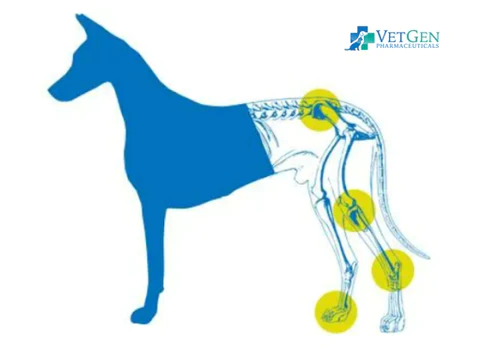Looking for a way to help your dog live a happier, healthier life? Glucosamine is one of the most popular canine supplements for keeping your dog healthy, but there’s so much information that it can make you feel like a dog chasing its tail.
It’s time to get educated today so you can help your dog fight back against degenerative conditions that can affect their mobility and quality of life.

What is Glucosamine?
Glucosamine is important for the integrity and health of your dog’s connective tissue. It is naturally found in joint cartilage and synovial fluid, which lubricates the joints and facilitates easy movement. Glucosamine helps maintain these structures by stimulating production of glycosaminoglycan (GAG) molecules, which are essential to forming new cartilage and maintaining the structure of mature cartilage.
In addition, glucosamine helps keep chondrocytes (cartilage-producing cells) healthy. It stimulates synoviocytes (synovial fluid-producing cells) to form hyaluronic acid, a key synovial fluid component vital for proper joint function.
Glucosamine for dogs is not “just another supplement” – it is a building block for connective tissue, without which your dog would have no cartilage or synovial fluid to keep their joints functional.
While canine hip dysplasia is more common amongst larger dogs, it can also affect smaller breeds.
Some dogs can start showing signs of hip dysplasia when they are only a few months old if their hip joint did not develop properly.
On the other hand, a minor misfit of the ball and socket may not lead to hip dysplasia until later in life.
In some cases, hip dysplasia in older dogs is catalyzed by osteoarthritis.
Let's Look At the Three Common Glucosamine Forms:

- N-Acetyl-Glucosamine: This form is derived from glucose, and is great for gastrointestinal and joint problems. It’s usually created from the outer shells of crustaceans.

- Glucosamine Sulfate: is the most common form found in many glucosamine supplement for dogs. It’s either made synthetically in a laboratory or taken from shellfish shells.

- Glucosamine Hydrochloride: This type is also found in shellfish, but it doesn’t have any sulfate. Because glucosamine hydrochloride lacks the sulfate group, it has 99% purity. Therefore, glucosamine hydrochloride in a dosage of 1,500 mg equals a dosage of 2,608 mg of glucosamine sulfate (Owens et al 2004).
It’s common for glucosamine to be combined with MSM or chondroitin, as both of these compounds are also great for maintaining joint health in dogs.
How Do Joint Supplements Help Dogs in General?

Help Maintain Joint Flexibility
Hip and joint supplements support cartilage growth in your dog’s joints.
You can also prevent degeneration of the joint cartilage by offering your dog the best supplements early on.

Alleviates Aches and Discomfort Associated with Daily Exercise
All that running, jumping, playing, and fetching takes a toll on your dog, especially when they get older.
Keeping your dog active even as they age is still incredibly important to their overall health.
By giving your dog hip and joint supplements, you can prevent or alleviate the pain they may start to feel from daily activities as they age.
Improve Well-Being and Cartilage Production in Aging Dogs

The best supplements for hips and joints should be packed full of glucosamine, chondroitin, and MSM (methylsulfonylmethane).
The glucosamine can help promote collagen production in cartilage, which prevents deterioration of the joints.
When paired with chondroitin, which fights off the cells that destroy cartilage, these two elements work hard to keep your aging dog’s joints feeling young.
MSM is a supplement ingredient that is a form of sulfur that can relieve pain from arthritis and joint pain.
How Does Glucosamine Benefit Dogs?
Glucosamine Hydrochloride can improve mobility and reduce pain in dogs that suffer from these conditions. In addition, it can help repair damage to the cartilage, which often occurs when there is an injury.
The cartilage helps cushion the joints, so any damage to it often leads to severe pain and stiffness in dogs.
Cartilage also becomes worn down with age, so older dogs are more likely to experience stiff joints and arthritis.
Glucosamine has proven to be a reliable solution for treating arthritis and other hip and joint problems.
Does Your Dog Need Glucosamine Supplements?
Here are some of the symptoms of canine arthritis to look out for:
- Stiffness, particularly in the morning or after long periods of inactivity
- Reluctance to climb stairs or jump onto furniture
- Less eagerness to go on walks or play with toys
- Lethargy and irritability
- Weight gain (because of less exercise)
- Changes in appetite, thirst, and sleep habits
- Having problems jumping on furniture or into the vehicle
- Not wanting to go upstairs
- Difficulties standing up or sitting down
- Limping
- Wanting to go on shorter walks
- Favoring one leg over the other
- Joints that are noticeably swollen
- Holding a limb in the air
- Audible cracking or popping sounds near the hips
At What Age Should You Start Your Dog On Glucosamine?
Some of the best joint supplements for dogs contain glucosamine, which can be given at any age. Studies have shown that about 20% of dogs one year or older and 80% of dogs over seven years of age suffer from achy, stiff joints and arthritis. But the important part is this: those numbers are based on the number of dogs who show symptoms. That means many more dogs have painful joints and arthritis than we ever see!
If you have a breed with a known genetic predisposition to joint problems such as hip dysplasia (like German Shepherds, Labrador Retrievers, Golden Retrievers, etc.), it’s especially important to start joint protection early.
Should You Give Glucosamine To Your Dog?
Glucosamine supplement for dogs can be given at most stages in life.
It’s been clinically proven to reduce symptoms of issues like arthritis, hip dysplasia, or other degenerative joint diseases, and definitely can’t hurt to try.
Even if your dog is not displaying these symptoms, it can be a good idea to consider hip and joint supplements for dogs.
Remember that preventing issues is easier than treating them.
It is hard to reverse once you’ve let an issue get too far out of control.
Of course, you should consult with your dog’s veterinarian before beginning any supplement regime, as they know your dog best and can answer questions you may still have.
How Can I Give My Dog Glucosamine?
Glucosamine can be administered in pill form like these beef flavored joint supplements for dogs. This is the easiest way to give your dog a glucosamine supplement, however, glucosamine can also be available in other forms such as liquids and powders. Generally, you administer them daily.
Natural glucosamine supplements can be pricey, but they work better than synthetic versions. Just be sure to determine the proper dosage for your dog, and while their dog food may claim to contain it – it’s probably much less than what a dog needs daily to maintain proper joint health.
After speaking with your veterinarian, they may suggest finding a glucosamine supplement containing chondroitin sulfate or MSM (methylsulfonylmethane).
Chondroitin is derived naturally from cows’ cartilage. This compound is excellent for helping retain the water in cartilage. MSM works to improve joints’ flexibility and reduce inflammation and pain.
Your dog can also eat certain types of food to get more glucosamine naturally. Foods such as chicken feet, pig or oxtails, bones, trachea, and beef knuckle bones are great source
Conclusion
In conclusion, it’s crucial to consider hip and joint supplements for dogs.
Problems with joints and hips can arise at any point in your dog’s life, so the sooner you begin using such supplements for prevention, the longer your dog will remain mobile.
One of the best joint supplements for dogs is Maximum Hip & Joint by VetGen Pharmaceuticals.
The chewable tablets are beef-flavored, so your dog will look forward to this “treat” each day. The best part is this supplement contains glucosamine, chondroitin, and MSM – so you can’t go wrong!






